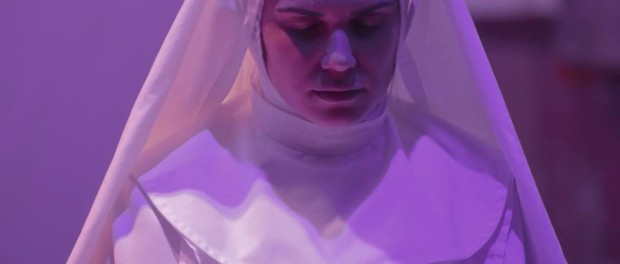Agnes of God : Debates from the 80s
Agnes of God is a crime drama with a theological spin. A young, beautiful, naive if not simple-minded nun Agnes (Isabel Farias Lehoux) is found unconscious in her room with a dead baby in her wastebasket strangled by its umbilical cord. The nun remembers nothing, believing that the baby’s existence is a story made up by the other sisters in her order. In an attempt to serve justice, the nun’s locked memories of the event become a battle ground between Agnes’ Mother Superior and a court appointed psychiatrist.
At heart, the show is a heady drama about the conflict between faith and science. Science, represented by the psychiatrist Dr. Martha Livingston (Tara Bissett), longs for facts and certainty. Faith, represented by the Mother Superior Miriam Ruth (Nancy Helms), longs for what serves the soul best. Each side uses its worldview to its advantage, raising a lively debate. But both faith and science are practiced by people who in no way live up to their principles entirely. The story becomes more complex as each side slowly reveals its hidden store of secrets. Unexpected bombs get dropped, weighing the contest first one way, and then another, so that the winner isn’t revealed until the final monologue.
Straeon’s Film Studios production does justice to a retro production, but there are still some kinks in the wimple. Many of the very things I liked in this production also had problems.
Perhaps the best reason to go to this show is the opportunity to sit in the space in Montreal’s old City Gas Building (next to New City Gas — now I know where the venue gets its name from!). The industrial space and spare set are gorgeous. Much is done with little to suggest innocence, purity, and piety. A white circle marks the stage and the seats surround it. Sheets billow around from the catwalk above, creating a very intimate atmosphere, fully appropriate for the show. An angel statue placed outside the curtains suggests that we are in the convent.
The actors perform in the round. They are conscious to block each scene around the stage so no one side is neglected for long. This works great until I found myself staring at the back of a character who was delivering a significant and emotional piece of information. I didn’t invest in this information and may have even missed some of its critical points. I certainly missed out on the actors’ faces and gestures.
The three actresses command attention. Martha, the psychiatrist, seems bitter and driven with a hate-on for Catholicism that only a former Catholic can hold. Her tough, justice-first side constantly competes with her softer, nurturing self. Mother Miriam initially appears with the chipper self-righteousness of the head of an order, and soon shows herself a lot more complicated than a bride of Christ. Agnes, though, was the most riveting of the three. Her first appearance overflows with beatific expression. She declares her “love” for everyone with an angelic smile that lights up a halo around her head. Agnes’ most emotional scenes, her hypnosis and her role play, are perfectly modulated — fascinating and engrossing. Farias Lehoux is a fantastic actress. But Agnes’ voice — so important for the show’s plot — is not Farias-Lehoux’s strongest performing trait. It isn’t comic (and how horrible that would have been), but listening to characters talk about this singular, angelic voice that drives them to protect her feels disingenuous.
As an ensemble, the actors have a good rapport that feels natural and serves to deepen the characters. In the earlier scenes, especially those between Martha and Miriam, the dialogue is off-pace. The actors speak atop one another’s words or respond too quickly, so that the delivery seems to lack confidence. Fortunately, the rougher earlier scenes yield to much stronger ones in the second half.
My biggest gripe of the whole show, though, is a broken light that flashed irregularly, creating a strobe effect that was distracting. 1/3 of the way through, the tech crew attended to it, but this remedy should have been found faster given that the light was stealing the show… and not because it was delivering the performance of a lifetime.
The play keeps its ’80s sensibility, but painted with a light brush. The set is too spare to indicate time, but the costumes are a tad more telling. I loved the costumes of Miriam and Agnes with their body-hiding austerity and massive crosses. It contrasted well with the shouldery jacket of Martha in her not-quite-a-suit power look. The dialogue is the dead give-away. Martha’s cigarette smoking struck me as a very ’80s trait — and when Martha and Miriam recount the smoking habits of Christianity’s who’s who fits with this. Compared with today, Martha’s psychological techniques seem dated. The hypnosis and role-play are very Freudian, drawn from psychoanalysis. I thought about how today, it’d be drugs and CBT instead.
Finally, there are some fascinating themes that take on greater relevance the more one reflects upon the production. Miriam and Martha are both women who are not mothers (a little more complicated for Miriam as you learn her story), and are “career” women of a kind. Yet both have chosen fields that require a level of care-giving and both take Agnes as their child. It’s interesting to consider how this production must have played to its original Broadway audience in 1983, a time when women were trying to break the glass ceiling in the business world, compared to now, when many women feel ashamed to justify a stay-at-home motherhood.
Agnes of God plays December 10-13 at the Montreal Light, Heat, and Power building (141 Rue Ann) on the third floor. Thursday-Saturday at 8 p.m, Sunday 3 p.m. $35/25/20. Get tickets HERE.





